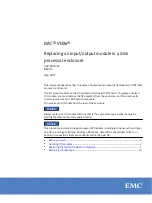
Emergency procedures (without an ESD kit)
In an emergency when an ESD kit is not available, use the following procedures to reduce
the possibility of an electrostatic discharge by ensuring that your body and the
subassembly are at the same electrostatic potential.
NOTICE
These procedures are not a substitute for the use of an ESD kit. Follow them only in the
event of an emergency.
l
Before touching any unit, touch a bare (unpainted) metal surface of the cabinet/rack
or enclosure.
l
Before removing any unit from its antistatic bag, place one hand firmly on a bare
metal surface of the cabinet/rack or enclosure, and at the same time, pick up the unit
while it is still sealed in the antistatic bag. Once you have done this, do not move
around the room or touch other furnishings, personnel, or surfaces until you have
installed the unit.
l
When you remove a unit from the antistatic bag, avoid touching any electronic
components and circuits on it.
l
If you must move around the room or touch other surfaces before installing a unit,
first place the unit back in the antistatic bag. When you are ready again to install the
unit, repeat these procedures.
Hardware acclimation times
Systems and components must acclimate to the operating environment before applying
power. This requires the unpackaged system or component to reside in the operating
environment for up to 16 hours in order to thermally stabilize and prevent condensation.
Table 1 Hardware acclimation times (systems and components)
If the last 24 hours of the
TRANSIT/STORAGE
environment was this:
…and the OPERATING
environment is this:
…then let the system or
component acclimate in
the new environment
this many hours:
Temperature
Humidity
Nominal
68-72°F (20-22°C)
Nominal
40-55% RH
Nominal 68-72°F (20-22°C)
40-55% RH
0-1 hour
Cold
<68°F (20°C)
Dry
<30% RH
<86°F (30°C)
4 hours
Cold
<68°F (20°C)
Damp
≥
30% RH
<86°F (30°C)
4 hours
Hot
>72°F (22°C)
Dry
<30% RH
<86°F (30°C)
4 hours
Hot
>72°F (22°C)
Humid
30-45% RH
<86°F (30°C)
4 hours
Humid
45-60% RH
<86°F (30°C)
8 hours
Replacing an input/output module in a disk processor enclosure
Emergency procedures (without an ESD kit)
3













